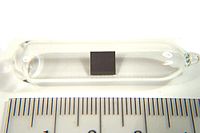
Photo from wikipedia
Abstract Advanced nuclear reactor concepts aim to use fuels that must withstand unprecedented temperature and radiation extremes. In these fuels, thermal energy transport under irradiation is directly related to fuel… Click to show full abstract
Abstract Advanced nuclear reactor concepts aim to use fuels that must withstand unprecedented temperature and radiation extremes. In these fuels, thermal energy transport under irradiation is directly related to fuel longevity, reactor safety, and is arguably one of the most important performance metrics. Here we provide a comprehensive, first-principles-informed treatment of phonon mediated thermal transport in a defect-bearing actinide oxide with direct comparison to experimental measurements. Pristine and proton irradiated thorium dioxide was chosen as a model system to treat the complexity of thermal transport in the presence of lattice defects. A thermal transport model is implemented using the linearized Boltzmann transport equation (LBTE) with input from first principles calculations and defect evolution models. Density functional theory is used to calculate phonon dispersion in thorium dioxide and used as an input to calculate both intrinsic and extrinsic, defect-induced relaxation times. In addition, a defect evolution model is benchmarked using microstructure characterization of as-irradiated thorium dioxide using a combination of electron microscopy and optical spectroscopy. The output of the LBTE is compared directly to mesoscopic measurements of thermal conductivity on length scales commensurate with defect accumulation. Parametric measurements of conductivity with irradiation dose and temperature suggest a saturation in the reduction of thermal conductivity with increasing defect generation, which is partially captured in our defect evolution model and LBTE framework. This comprehensive, atomistic to meso-scale treatment provides the necessary basis to investigate thermal transport under irradiation in more complex systems that exhibit strong electron correlation.
Journal Title: Acta Materialia
Year Published: 2021
Link to full text (if available)
Share on Social Media: Sign Up to like & get
recommendations!